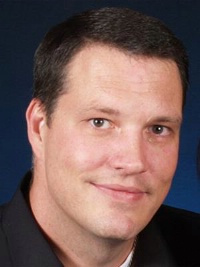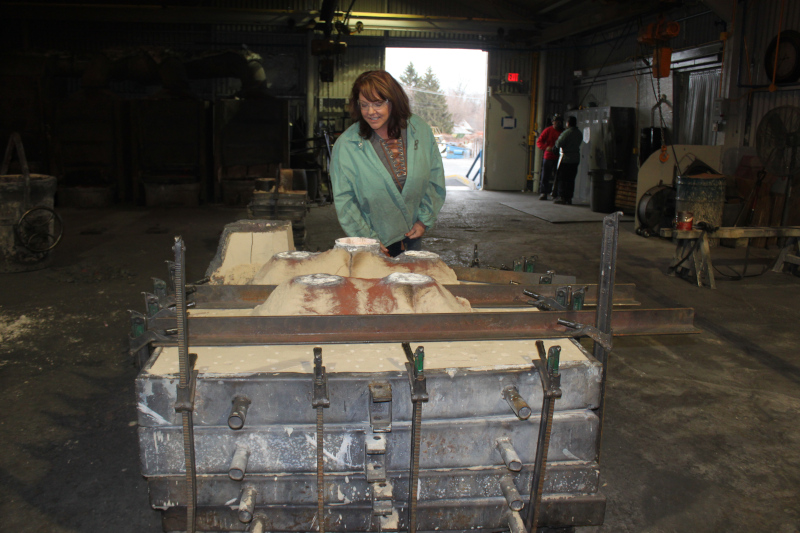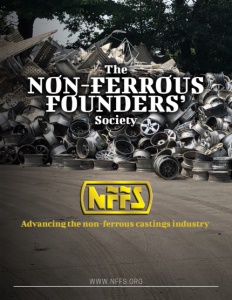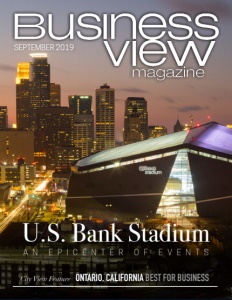Advancing the non-ferrous castings industry

Jerrod Weaver, Executive Director
Established in 1943, the Non-Ferrous Founders’ Society (NFFS) is a 501(c)(6) trade association serving non-ferrous foundries, die casters, and ingot manufacturers. NFFS members produce non-ferrous metal castings from a wide variety of materials including aluminum, brass/bronze, zinc, lead, and other materials, principally via the sand, permanent mold, investment casting, continuous cast and die-casting casting processes. NFFS member foundries are concentrated in the traditional manufacturing regions, primarily the Great Lakes states, along the Eastern Seaboard, and on the West Coast. The castings manufactured by foundries are an important part of the U.S. economy and are widely used in most economic segments. Castings are particularly important in automotive, energy/power generation, medical technologies, military/defense, plumbing and fluid handling, industrial, marine, tooling & machinery, housing, construction, and aircraft industries.
There are approximately 950 non-ferrous foundries and die casters in the United States. Industry census data reveals nearly 85 percent of non-ferrous foundries are small businesses employing less than 250 employees, though some large facilities can employ more than 500 workers. Many non-ferrous foundries are family-owned businesses and employ multiple generations of the same family.
NFFS provides a wide variety of membership benefits and services, including written regulatory compliance programs, newsletters, foundry specific safety training programs, economic reports, industry advocacy and representation, members-only affinity programs, and customer market development activities. NFFS often times submits written comments and oral testimony on behalf of the industry during the development of new and revised regulations affecting its members, and actively advocates on behalf of the industry.
Recently, Business View Magazine spoke with Jerrod Weaver, Executive Director of the NFFS to find out more about the organization. The following is an edited transcript of that conversation, plus additional written material that Weaver supplied.
BVM: Can you talk about the history of the Society, why and how it got started, and what its current mandate is, today?
Weaver: “In January 1942, President Franklin D. Roosevelt established the War Production Board (WPB) with Executive Order 9024. The national WPB’s primary task was converting civilian industry to war production. It also assigned priorities and allocated scarce materials such as steel, aluminum, copper and rubber, prohibited nonessential industrial production such as nylons and refrigerators, controlled wages and prices, and mobilized the people through patriotic messages and events such as scrap drives.
“One of the things that happened was that the industry was negatively impacted because it had an inability to secure copper to produce not only the war production needs, but also the commercial needs of the U.S. economy.
“Another challenge facing foundries was the Office of Price Administration (OPA), established by in 1941. The OPA had the power to place ceilings on all prices except agricultural commodities, and to ration scare supplies of other items, including metals. In 1943, the OPA instituted a $0.015 uniform price reduction on all castings to “continue a situation in which prices were definitely known and knowable to purchasers.” Foundries were being dictated a price reduction in an environment where the raw materials, such as scrap and ingot, did not decrease in cost. This presented an untenable situation for foundries, and many foundries were placed at great risk of economic harm and/or failure.
“In turn, nonferrous foundries organized into what became NFFS to represent their collective interests. NFFS first organized on April 28, 1943 at the Statler Hotel in St. Louis, Missouri. Its main purpose, at the time, was to work directly with the War Production Board to help non-ferrous foundries obtain critical supplies of scrap and ingot metal for casting production needs, and to represent the industry to the OPA to try and protect the industry from damaging economic policies.
“NFFS officially incorporated as a not-for-profit trade association on August 18th, 1945 in the State of Illinois. Offices were originally located in downtown Chicago. The offices were relocated to Cleveland, Ohio during the 1960s, and returned back to Illinois in the 1970s. We moved to Park Ridge in 1998, and at the end of June 2019 we relocated our offices to Sturgis, Michigan.
“From its inception, NFFS was created to assist non-ferrous foundries in dealing with government regulations and to represent the industry when government rules and regulations affected its member’s businesses. While the names and faces of the members, directors, and staff for the Society may have changed over the past 75 years, the focus of the Society has remained to represent the concerns and interests of the non-ferrous metal casting industry.”

NFFS Board Member and President of Calumet Brass Foundry (Dolton, Illinois) inspects a mold poured by her production team.
BVM: What is your membership, how do you communicate with them, and how do you explain the benefits of membership to potential members?
Weaver: “The Non-Ferrous Founders’ Society has two different tiers of membership, regular members that melt and pour non-ferrous materials or ingot, and associate members, which include ferrous foundries as well as leading industry suppliers to the cast metals industry. The recent adoption of the associate membership category is a significant change for NFFS. The category, launched in 2018, was developed in response to the recognition by the Board of Directors that the non-ferrous casting industry consists not only of the foundries themselves, but also includes foundries that pour other materials and the critical industry suppliers that enable foundries to operate successfully. The Board properly recognized that in order to represent the entire nonferrous metal casting industry, supplier organizations needed to be represented by NFFS, as well.
“NFFS has been very successful in maintaining is membership growth. We’ve added nearly 50 percent to the membership roster over the last three years. This success is due in large part to the NFFS membership committee and its tireless efforts to communicate how NFFS helps to address the concerns and interests of the non-ferrous metal casting industry. The Membership Committee also led the way in developing the associate membership category and the related programs and services available to that membership category. However, as with most associations, the challenge is how to properly define the benefits of belonging to a potential member. This is where NFFS has been exceptionally strong.
“One of our strengths is in the Occupational Safety, Health, and Environmental programs that have been developed specifically for non-ferrous foundries. Many times, NFFS has provided template documents that can significantly improve a member’s safety program by utilizing industry best practices and by providing a means for members to benchmark their own programs against others in the industry. NFFS members consistently rank the support they receive from NFFS regarding OSHA and EPA issues as among the most important and useful membership offering by the Society.
“NFFS also works hard to develop new customer markets, and expand volumes in existing customer markets, on behalf of the industry. As an example, our ICON portal is an innovative new technology that links the casting needs of the defense and military supply chains with the foundries that have the right combination of materials and processes required to manufacture those parts, or to connect those customers with foundries that already have existing tooling for those same parts. Either solution significantly reduces the effort required to locate foundry suppliers by customers, and helps to ensure that these product orders remain fulfilled by American foundries. NFFS is proud of the ICON portal and the significant impact it has had on reducing the backlog for unfilled casting orders by the U.S. armed services, and is proud to help support America’s war fighters by providing high quality cast components in a cost-effective and timely manner.
“NFFS utilizes traditional communication channels, such as email, webinars, and digital newsletters, to speak to its members and to the industry. However, NFFS places real value on interpersonal communication. This is why NFFS works so hard to hold regional meetings and events, where the NFFS staff and Society leadership have a chance to speak one-on-one with our foundry members and industry stakeholders. The NFFS staff also works diligently to regularly visit NFFS member foundries, and learn about the challenges they face first hand. While digital communications have their role to play, NFFS considers the face-to-face communications to be the most informative and fruitful method to speak directly to our industry partners.
“Some may argue that the real value of NFFS is the proactive effort the Society invests in defending the industry from harmful new or revised regulations. I will give you an example. Back in 2009, the EPA issued the MACT standards, as required under the Clean Air Act of 1970. The ZZZZZZ rule, or 6Z rule, was developed to address control technologies for non-ferrous foundries. When the EPA was working on crafting the 6Z rule, NFFS worked with the consultants who were writing the rule on behalf of the EPA to identify the feasible maximum control technologies for nonferrous foundries. As a result of NFFS’s efforts, the 6Z rule had several important exemptions for non-ferrous foundries not granted to other industries, such as Iron and Steel Foundries under the 5Z rule. Non-ferrous foundries are not required to do the semi-annual compliance reporting and are exempt for visual stack testing requirements, for example. These exemptions, alone, save non-ferrous foundries tens of thousands of dollars each in overhead costs that would otherwise be necessary to comply with the rule. These types of successes are rarely visible to the regulated industry, but NFFS is proud to be on constant vigil and ready to defend our industry in any way that we can.”
BVM: What is the size of the Society’s staff, and what are their main responsibilities?
Weaver: “Like many small businesses, NFFS manages to accomplish a significant amount with a very small staff. NFFS employs three full-time staff members, and one part-time staff member.
“Erin Russell is the Society’s Director of Membership and Communication. Erin is responsible for managing the publications and newsletters of the Society, is the staff liaison to the NFFS membership and scholarship committees, and is the primary customer service point of contact for NFFS members. Erin has been with the Society for just over two years, and has already become a key employee in her short tenure.
“Sheila Rayburn is the ICON program manager, responsible for managing the ICON program and the NFFS relationships with the Defense Logistics Agency. Sheila also serves as the NFFS representative on the American Metalcasting Consortium’s (AMC) Technical Advisory Committee, representing NFFS members within the AMC program. Sheila joined the staff about one year ago after serving nearly 30 years with the Defense Logistics Agency as a contracting officer.
“Kristie Matusek is our part time employee, but performs like a full-time employee. Kristie is well known among the Society membership as our meetings and events specialist. She does a great job in helping NFFS organize meetings and conferences that are not only educational, but a heck of a lot of fun, as well. Kristie has worked with NFFS on a formal basis for four years, but has provided support for the NFFS meetings for nearly a decade.
“Finally, I have served as Executive Director of the Society for about three and a half years now. Prior to serving as Executive Director, I worked for 19 years as a NFFS staff member in a variety of roles, and working with nearly every NFFS member and NFFS program in some capacity during that time. I am very fortunate to have found a career that is as long lasting, and as satisfying, as my work with NFFS has been so far.
“NFFS focuses on maximizing employee productivity by providing technology that allows our small staff to be as efficient as possible. We have implemented video conferencing for our staff and committees, and are working to implement a new software system to manage our internal information and customer files. This allows NFFS to consistently operate at a high level with a limited staff. I truly believe the existing NFFS staff is among the most talented and capable group of individuals I have ever had the pleasure of working with. I am continually amazed by both the amount of work that each staff member accomplishes, and the high-level of quality and professionalism they demonstrate while doing it.”
BVM: What is currently topping your agenda and what are the most relevant issues facing the Society’s membership?
Weaver: “Non-Ferrous foundries face many of the same challenges that other industries and manufacturers are facing in the coming decade. Among the most important issues is the ongoing shortage of talented artisans and laborers available to work in non-ferrous foundries. The labor shortage is already having a significant impact on our industry by limiting capacity growth, and the future looks to be even more challenging.
“For example, earlier this year CNBC reported on the 15 occupations that will experience the biggest decline in employment numbers over the next seven years. Hand grinders and polishers, ubiquitous in the foundry industry, is number 15 on the list and is expecting nearly a 20 percent reduction in the number of workers employed in this category. Metal pourers and casters were number eight on the list, projecting a 23 percent reduction. Foundry mold and core makers are number seven, and expected to lose over 24 percent of employees in this category. Cleary, with three of the top 15 occupations that will experience the largest decline in employee counts, the foundry industry has a significant challenge in the coming years.
“NFFS is already working on plans to remain relevant to the industry and its members in this new environment. We are working on a funding model that is not based upon employment counts in the industry, and are working on solutions to help foundries with the critical skilled labor that will remain in demand for the foreseeable future. Even with significant automation in the molding, pouring, and grinding areas, foundries will continue to need an influx of talented engineers, managers, and skilled tradespeople such as machinists, welders, and CNC programmers. NFFS has developed a targeted scholarship program to attract the nation’s best and brightest students to a career in non-ferrous metal casting.
“I also believe that it is worth mentioning additive manufacturing as well. Many see additive manufacturing as a replacement technology that will supersede our nation’s need for nonferrous foundries. This is simply not the case. Additive manufacturing has been adopted by many in our industry already, not to print metal components, but to use as part of the traditional foundry manufacturing process. Additive manufacturing helps foundries to make tooling, print complete sand molds and core assemblies, print ceramic investment casting shells and waxes, and provide rapid prototyping services. The efficiencies that additive manufacturing provides foundries are actually a net benefit to the foundry industry. Sure, there will always be winners and losers with any new technology, but for the foreseeable future additive manufacturing will not be cost-effective for manufacturing large numbers of nonferrous metal castings for use in the U.S. economy.”
BVM: What is your view of the non-ferrous industry, as a whole, going forward?
Weaver: “I believe the industry’s health is solid, long-term, but I think the mix of work that is done in non-ferrous foundries will change slightly. We’ve already seen the high-volume, low-complexity jobs move to locations with lower labor costs, such as China, and there’s a whole host of those countries coming in the future, in places like Africa. The high-volume, low-margin product types will continue to face pressure to migrate out of the country as economic demands dictate. Where the future is brightest for American non-ferrous foundries will be the low-to-medium volume, high-quality, highly-engineered cast components that are critical for advanced technologies and industries.”
BVM: What are the most important points that you would like our readers to know about the NFFS?
Weaver: “That’s a great question. I think that there are a couple of things that I hope a reader would take away from this article. One, foundries really have an undeserved bad reputation among the general public. The perception is that foundries are dark, dirty, low-tech, heavy industrial environments that are full of smoke and employee hazards and are poor environmental citizens. And nothing could be further from the truth. The truth is, if you actually visit almost any non-ferrous foundry in this country, you will see a professional work environment that is well lit, clean, and filled with advanced technology. Foundries routinely use computer simulation and computer controls as part of their planning and production processes, often times have advanced analytical instruments capable of measuring metal content within alloys out to 0.001%, and many have advanced non-destructive testing equipment right out on the foundry floor. Perhaps the more important point is that foundries are the original environmental champions. Foundries have been recycling metal for thousands of years, and long before recycling was ‘cool’.
“The second point I would hope that a reader would take away is that the non-ferrous foundry industry is a vibrant and exciting place to work. For too long we have told our youth to be doctors, Lawyers, or accountants, and have totally ignored the rich tapestry of opportunity available in the manufacturing trades. Non-ferrous foundries provide well-paying careers for tens of thousands of American families, and the opportunities in this industry have never been greater. Not only are there opportunities to start on the ground floor for entry level workers, there are literally hundreds of job openings right now for talented engineers, accountants, managers, and executives as well. My experience over the last 20-plus years in the industry is that once a young employee enters the non-ferrous metal casting industry, they tend to become life-long industry employees. Hopefully we are able to convince the next generation that working in manufacturing, and especially with cast metals, is a great career path and one that helps ensure America remains a manufacturing powerhouse in the global economy.”
AT A GLANCE
WHO: The Non Ferrous Founders’ Society
WHAT: A trade association serving non-ferrous metal casting industry
WHERE: Sturgis, Michigan
WEBSITE: www.nffs.org



